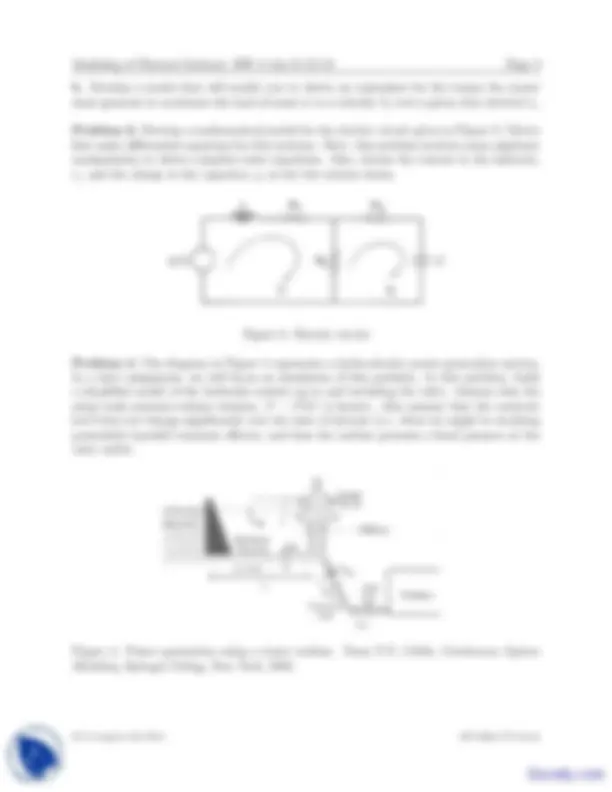



Study with the several resources on Docsity

Earn points by helping other students or get them with a premium plan


Prepare for your exams
Study with the several resources on Docsity

Earn points to download
Earn points by helping other students or get them with a premium plan
Community
Ask the community for help and clear up your study doubts
Discover the best universities in your country according to Docsity users
Free resources
Download our free guides on studying techniques, anxiety management strategies, and thesis advice from Docsity tutors
Problems and solutions related to modeling physical systems using ideal model elements. The problems involve unbalanced fans, belt drives, and electric circuits. Students are required to draw schematics, derive mathematical models, and prove physical effects. Assumptions and required information are discussed.
Typology: Exercises
1 / 2

This page cannot be seen from the preview
Don't miss anything!


Modeling of Physical Systems: HW 2–due 9/13/12 Page 1
Problem 1: A motor-driven fan (or blower) is mounted on a steel frame which is rigidly attached to the floor as shown in Figure 1. The rotor is unbalanced, and forced rotation at angular velocity, ω, induces a dynamic force on the main shaft. Assume you are given net weight/mass of the blower, M , and you can measure static deflection of the frame when the fan is mounted on it. You might also be given or can determine the ‘eccentric’ mass on the rotor, say m, as well its radial eccentricity, e, from the shaft center.
Figure 1: Unbalanced fan/blower
a. Draw a schematic that represents how you would model this problem; i.e., using ideal model elements (masses, spring elements, damp- ing, etc.). List the specific constitutive relations for all model elements. Include an input forcing due to the unbalanced rotor rotation. Discuss assumptions you would make, and list informa- tion you would need to have. Justify all physical effects you include in your model.
b. Prove that you can model the force applied by the unbalanced rotor by a one-dimensional dynamic force in the vertical direction (call it z). Also show that this force can be quantified by, F (t) = Fosin(ωt), and determine how Fo and ω are related to the physical parameters of the problem (parameters for your model, speed of rotation, etc.).
c. The most fundamental model of the vertical motion of the total fan mass can be repre- sented by a second order differential equation. Derive this mathematical model.
Figure 2: Basic belt drive
Problem 2: Consider the system shown in Fig- ure 2. A stepper motor drives pulley A, which has moment of inertia JA, the timing belt has total mass m, and pulley B has moment of in- ertia, JB. There is static friction acting in the rotational elements (which we can assume move together) that has been measured at the input shaft (at A) as, Tf. Assume that the shafts and the belts are very stiff (negligible compliance).
a. To simplify the model, develop an expression for the effective rotational inertia, Jeff , seen at the motor shaft. Use energy and speed relations, and assume that the two pulleys have equal di- ameters.
R.G. Longoria, Fall 2012 ME 383Q, UT-Austin
Modeling of Physical Systems: HW 2–due 9/13/12 Page 2
b. Develop a model that will enable you to derive an expression for the torque the motor must generate to accelerate the load of mass m to a velocity Va over a given time interval ta.
Problem 3: Develop a mathematical model for the electric circuit given in Figure 3. Derive first order differential equations for this systems. Note: this problem involves some algebraic manipulation to derive complete state equations. Also, choose the current in the inductor, i 1 , and the charge in the capacitor, q, as the two system states.
Figure 3: Electric circuit
Problem 4: The diagram in Figure 4 represents a hydro-electric power generation system. In a later assignment, we will focus on simulation of this problem. In this problem, build a simplified model of the hydraulic system up to and including the valve. Assume that the surge tank pressure-volume relation, P = P (–V ) is known. Also assume that the reservoir level does not change significantly over the time of interest (i.e., when we might be studying potentially harmful transient effects), and that the turbine presents a fixed pressure at the valve outlet.
Figure 4: Power generation using a water turbine. From F.E. Cellier Continuous System Modeling, Springer-Verlag, New York, 1991.
R.G. Longoria, Fall 2012 ME 383Q, UT-Austin